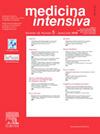Anti-Xa activity below range is related to thrombosis in patients with severe COVID-19
IF 2.7
4区 医学
Q2 CRITICAL CARE MEDICINE
引用次数: 0
Abstract
Objective
We aimed to anlayse the relationship between anti-Xa activity below range and thomboembolic events.
Design
Single center prospective observational longitudinal cohort study (February–November 2021).
Setting
Patients admitted to the ICU of a University Hospital.
Participants
Patients with severe COVID-19 pneumoniae.
Interventions
Enoxaparin was used for prophylactic and therapeutic anticoagulation. Enoxaparin dosing and dose adjustment were based on anti-Xa activity according to the hospital protocol.
Main variables of interest
Target: thomboembolic events.
Predictors: demographics, pharmacotherapy, anti-Xa measurements, clinical data, and laboratory results.
Logistic regression was used to identify independent risk factors for thomboembolic events.
Results
Data were available for 896 serum anti-Xa measurements from 228 subjects. Overall, 71.9% were male, with a median age of 62. Most patients needed invasive mechanical ventilation (87.7%) and mortality was 24.1%. A total of 28.9% new thomboembolic events were diagnosed. There were 27.1% anti-Xa measesurements below range. When multivariable logistic regression analysis was performed anti-Xa activity below range (RR, 4.2; p = 0.000), C-reactive protein (25 mg/L increase) (RR, 1.14; p = 0.005) and D-dimer (1000 ng/L increase) (RR, 1.06; p = 0.002) were the independent factors related to new thomboembolic events in patients with severe COVID-19.
Conclusions
Anti-Xa activity below range, C-reactive protein and D-dimer were the independent factors related to thomboembolic events in patients with severe COVID-19. Purposely designed clinical trials should be carried out to confirm the benefit of an anti-Xa monitoring.
抗xa活性低于范围与重症COVID-19患者血栓形成有关
目的分析抗xa活性低于正常值与血栓事件的关系。设计单中心前瞻性观察性纵向队列研究(2021年2月- 11月)。场景:某大学附属医院ICU收治的患者。参与者:重症COVID-19肺炎患者。干预措施:诺肝素用于预防性和治疗性抗凝。依诺肝素的给药和剂量调整以抗xa活性为基础,根据医院方案。主要感兴趣的变量目标:血栓事件。预测因素:人口统计学、药物治疗、抗xa测量、临床数据和实验室结果。使用逻辑回归来确定血栓事件的独立危险因素。结果228例受试者共获得896项血清抗xa测定数据。总体而言,71.9%为男性,中位年龄为62岁。大多数患者需要有创机械通气(87.7%),死亡率为24.1%。共诊断出28.9%的新血栓事件。有27.1%的抗xa测量值低于量程。当进行多变量logistic回归分析时,抗xa活性低于范围(RR, 4.2;p = 0.000), c -反应蛋白(升高25 mg/L) (RR, 1.14;p = 0.005)和d -二聚体(增加1000 ng/L) (RR, 1.06;p = 0.002)是与重症COVID-19患者新发血栓事件相关的独立因素。结论抗xa活性过低、c反应蛋白和d -二聚体是重症COVID-19患者血栓事件的独立影响因素。应该进行有目的设计的临床试验,以确认抗xa监测的益处。
本文章由计算机程序翻译,如有差异,请以英文原文为准。
求助全文
约1分钟内获得全文
求助全文
来源期刊

Medicina Intensiva
CRITICAL CARE MEDICINE-
CiteScore
2.70
自引率
20.00%
发文量
146
审稿时长
33 days
期刊介绍:
Medicina Intensiva is the journal of the Spanish Society of Intensive Care Medicine and Coronary Units (SEMICYUC) and of Pan American and Iberian Federation of Societies of Intensive and Critical Care Medicine. Medicina Intensiva has become the reference publication in Spanish in its field. The journal mainly publishes Original Articles, Reviews, Clinical Notes, Consensus Documents, Images, and other information relevant to the specialty. All works go through a rigorous selection process. The journal accepts submissions of articles in English and in Spanish languages. The journal follows the publication requirements of the International Committee of Medical Journal Editors (ICMJE) and the Committee on Publication Ethics (COPE).
 求助内容:
求助内容: 应助结果提醒方式:
应助结果提醒方式:


